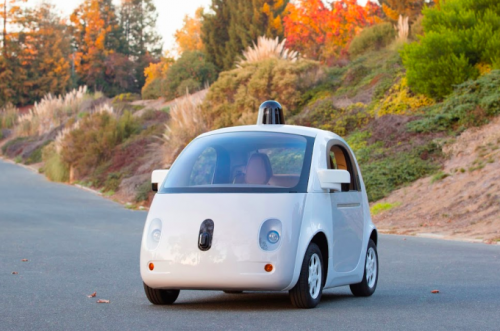The finalized prototype of Google self-driving car. Credit: Google
Self-driving cars may one day take a direction away from wires that are needed to plug in for charging.
The wireless wish has turned into an action plan, with its wireless charging system now having reached the testing stage. IEEE Spectrum reported that there have been documents filed at the FCC on that note. The documents suggest Google would like to explore cutting the charger cables.
Mark Harris in IEEE Spectrum said the filings reveal they have in mind wireless charging systems for the prototype electric self-driving cars in California. ("All the prototype cars currently being tested in public are recharged using traditional conductive charging cables," wrote Harris.)
In discussing wireless charging, he explained the principle of resonant magnetic induction. "In this process, an alternating current passing through a tuned electrical circuit creates an oscillating magnetic field. That field then induces another alternating current in a second, nearby circuit tuned to the same resonant frequency."
The systems transfer power from a transmitter embedded in the ground to a receiver on the underside of an electric vehicle. One of the prototypes, Alpha, from HEVO (Hybrid & Electric Vehicle Optimization) Power, can deliver 1.5 kilowatts of power from a transmitter embedded like a manhole cover in pavement. Also, multiple chargers from Momentum Dynamics are being tested in California.
No types of company partner announcements have been made, however; both HEVO Power and Momentum Dynamics, said IEEE Spectrum, declined to confirm Google involvement.
Google itself noted only that it tests many different technologies for its self-driving vehicles, Harris added.
If electric self-driving cars are able to thrive on wireless charging systems, that would carry major advantages and could possibly ease people's reluctance in taking an electric self-driving car out on the road.
Smaller, lighter batteries for electrical cars could be used in this manner; the car would be continually recharging as it travels along the road. Smaller and lighter batteries would also carry more design freedom for car makers; even the price for electric cars could come down.
Charging systems that are wireless will continue to be a focus of research and development across borders. Last year, the International Business Times reported that the UK was to begin tests on a system for charging electric cars while the cars drove along roads.
In Germany, Fraunhofer (an application-oriented research organization) reported in August that "researchers at Fraunhofer institutes built a 25-meter-long test route along which coils were set into the road.
The project, according to the announcement, was stated to have been a success: the demonstrator, a sports car converted into an electric vehicle, managed to travel the strip at a moderate speed while simultaneously charging its battery.
© 2016 Tech Xplore






















